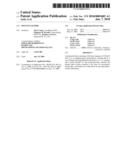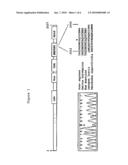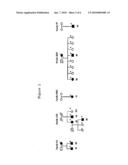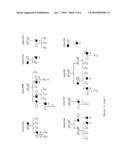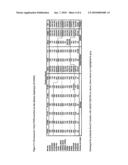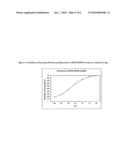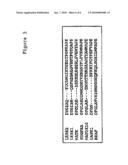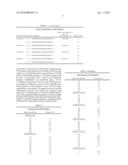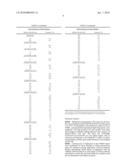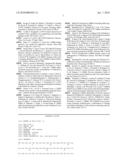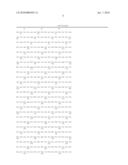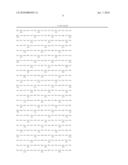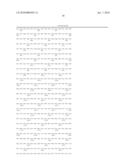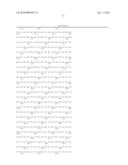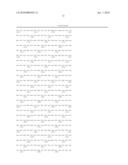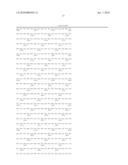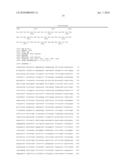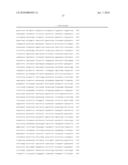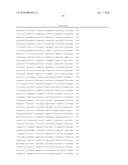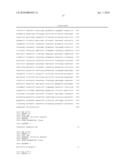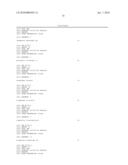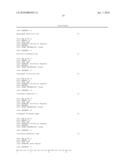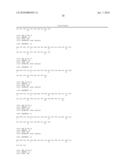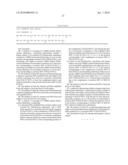Patent application title: POLYNUCLEOTIDE
Inventors:
Jan O Aasly (Trondheim, NO)
Zbigniew K Wszolek (Jacksonville, MN, US)
Matthew J. Farrer (Jacksonville, FL, US)
IPC8 Class: AC12Q168FI
USPC Class:
435 6
Class name: Chemistry: molecular biology and microbiology measuring or testing process involving enzymes or micro-organisms; composition or test strip therefore; processes of forming such composition or test strip involving nucleic acid
Publication date: 2010-01-07
Patent application number: 20100003685
Claims:
1-9. (canceled)
10. A method of screening for LRRK2-related Parkinsonism inheritance, comprising determining whether a human subject to be screened for Parkinsonism inheritance comprises a LRRK2 polynucleotide having a G or an A at the position corresponding to position 6055 of SEQ ID NO:2, and classifying said subject as having LRRK2-related Parkinsonism inheritance if said subject comprises an A at the position corresponding to position 6055 of SEQ ID NO:2, or classifying said subject as not having LRRK2-related Parkinsonism inheritance if said subject comprises a G at the position corresponding to position 6055 of SEQ ID NO:2.
11. The method of claim 10, wherein said determining step comprises contacting DNA amplified from said subject with a probe containing more than ten consecutive nucleotides from SEQ ID NO:2 or from the complement thereof, and wherein said probe contains nucleotide position 6055 of SEQ ID NO:2.
12. The method of claim 11, wherein said DNA amplified from said subject is from the blood of said subject.
13. The method of claim 10, wherein said determining step comprises amplifying DNA from said subject and sequencing said amplified DNA.
14. The method of claim 13, wherein said DNA from said subject is from the blood of said subject.
15. A method of screening for LRRK2-related Parkinsonism inheritance, comprising:(a) contacting DNA amplified from a human subject to be screened for Parkinsonism inheritance with a DNA probe specific for a polynucleotide having the sequence of SEQ ID NO:2 or the complement of SEQ ID NO:2, wherein said probe contains more than ten consecutive nucleotides from SEQ ID NO:2 or from the complement thereof, wherein said probe contains nucleotide position 6055 of SEQ ID NO:2 or the corresponding position of the complement of SEQ ID NO:2, and wherein the ability of said probe to hybridize to said amplified DNA indicates whether said subject has an A or a G at position 6055 of SEQ ID NO:2 or a T or a C at the position corresponding to the complement of position 6055 of SEQ ID NO:2; and(b) based on said hybridization, classifying said human subject as having LRRK2-related Parkinsonism inheritance if said DNA amplified from said subject has an A at position 6055 of SEQ ID NO:2 or a T at the position corresponding to the complement of position 6055 of SEQ ID NO:2, and classifying said human subject as not having LRRK2-related Parkinsonism inheritance if said DNA amplified from said subject has a G at position 6055 of SEQ ID NO:2 or a C at the position corresponding to the complement of position 6055 of SEQ ID NO:2.
16. The method of claim 15, wherein said DNA is from the blood of said subject.
17. A method for determining whether a human subject has Parkinsonism inheritance, comprising providing a sample of material from said subject, and assaying said sample to determine whether said sample comprises a polynucleotide corresponding to SEQ ID NO:2, with the proviso that said polynucleotide comprises an A at the position corresponding to position 6055 of SEQ ID NO:2, wherein the presence of an A at the position corresponding to position 6055 of SEQ ID NO:2 indicates Parkinsonism inheritance.
18. The method of claim 17, comprising diagnosing said subject as having Parkinsonism inheritance if said polynucleotide comprises an A at position 6055 of SEQ ID NO:2.
19. The method of claim 17, wherein said sample is a blood sample.
Description:
[0001]This application is a continuation of U.S. Ser. No. 10/568,414,
filed Jul. 12, 2006, which is a National Stage application under 35
U.S.C. § 371 and claims benefit under 35 U.S.C. § 119(a) of
International Application No. PCT/NO2005/00465, having an International
Filing Date of Dec. 19, 2005, which claims priority from Norwegian
Application No. 20052535, filed May 27, 2005, and Norwegian Application
No. 20045612, filed on Dec. 23, 2004. Present invention relates to a
novel polynucleotide involved in heritable Parkinson's disease (PD), a
novel polypeptide encoded by the polynucleotide, and a method for
diagnosing heritable Parkinson's disease (PD).
[0002]Present invention relates to a novel polynucleotide involved in heritable Parkinson's disease (PD), a novel polypeptide encoded by the polynucleotide, and a method for diagnosing heritable Parkinson's disease (PD).
BACKGROUND
[0003]Parkinsonism (MIM168600) is a clinical syndrome characterized by bradykinesia, resting tremor, muscle rigidity, and postural instability (Gelb et al. 1999). The most common cause of parkinsonism is Parkinson's disease (PD). Second to Alzheimer's disease, PD is the most common neurodegenerative disorder affecting >1% of the population over 55 years of age (de Rijk et al. 1995). Neuropathological findings in PD are loss of pigmented neurons in the brainstem, substantia nigra and locus ceruleus, with intracellular Lewy body inclusions found within surviving neurons (Forno 1996).
[0004]Although PD is considered a sporadic disease, various hereditary forms of parkinsonism have been recognized (Vila and Przedborski 2004). A major breakthrough in recent years has been the mapping and cloning of a number of genes causing monogenic forms of parkinsonism. Genomic multiplication and missense mutations in the α-synuclein gene were initially identified in a small number of families with autosomal dominant parkinsonism (PARK1/4 [MIM 168601]) (Polymeropoulos et al. 1997; Kruger et al. 1998; Singleton et al. 2003; Chartier-Harlin et al. 2004; Farrer et al. 2004; Zarranz et al. 2004). Subsequently, α-synuclein antibodies were found to robustly stain Lewy bodies and Lewy neurites in the substantia nigra in familial and sporadic PD (Spillantini et al. 1997) and common genetic variability in the α-synuclein promoter has been implicated in sporadic PD (Pals et al. 2004).
[0005]Autosomal recessive mutations in three genes, parkin, DJ-1 and PINK1 have been linked with early-onset parkinsonism (<45 years at onset) (PARK2, PARK6 & PARK7 [MIM 602533, 602544 & 608309]) (Kitada et al. 1998; Bonifati et al. 2003; Valente et al. 2004). A large number of pathogenic mutations and rearrangements have been identified in the parkin gene reviewed by (Mata et al. 2004), but mutations in DJ-1 and PINK-1 arc rare (unpublished data).
[0006]Very recently, five pathogenic mutations were identified in a gene, leucine-rich repeat kinase 2 (LRRK2) in six families with autosomal-dominant parkinsonism, linked to the PARK8 locus [MIM 607060]) (Zimprich et al. 2004a). Paisan-Ruiz and colleagues independently confirmed these findings of two pathogenic mutations in a British and Basque families (Paisan-Ruiz et al. x2004).
OBJECT
[0007]The object of the invention is to isolate a gene or polynucleotide proving inheritable parkinsonism, and to use presence of this gene to diagnose a patient before he/her gets sick. A further object is to use this gene or polynucleotide to transfect a microorganism or experimental animal in order to develop a new medicine for treating or preventing the onset of parkinsonism.
THE INVENTION
[0008]Inheritable parkinsonism may be proved by the method according to the characterizing part of claim 5, and the other objects are met by a polynucleotide according to the characterizing part of claim 1, a recombinant vector according to claim 3, a DNA probe and a DNA primer according to claims 4 and 6 respectively, and a peptide according to claim 9.
[0009]The inventors have isolated a novel LRRK2 mutation, and this mutation may cause development of dominantly inherited PD. By screening healthy persons, one can state whether the healthy persons have the mutation, and thus most likely will develop the illness.
[0010]Using a probe to test whether a patient has the mutation allows a precise, differential diagnosis of this type of Parkinson's disease. The probe represents a safe and accurate biomarker which will be powerful as it nominates subjects, future patients, for neuroprotective therapy. At the present time this is a research enterprise, but not for long. These subjects provide the first (and only) `uniform substrate/background` for studies on drug efficacy/safety. From a research perspective they will also facilitate models of disease (C. elegans, Drosophila, mice) and epidemiological research on the variable expressivity and age-associated penetrance. As the sequence of the mutated gene is known, microorganisms and further experimental animals may be transfected, in order to investigate for a new medicine to treat or prevent the onset of the illness.
[0011]The genetic information provides subjects with the cause of their disease, an explanation for which, if handled correctly, can be of great psychological benefit (fulfilling the `need to know` why). This information also prioritizes the resources of the research community, grant funding agencies and the pharmaceutical industry on developing a neuroprotective therapies to halt G2019S disease progression.
[0012]In the following the invention will be described by reference to a study of PD patients and their families. Parts of the study are shown in figures, wherein
[0013]FIG. 1 shows a schematic drawing of LRRK2 with predicted protein domains,
[0014]FIG. 2 shows pedigrees of families with LRRK2 G2019S,
[0015]FIG. 3 shows chromosome 12q12 STR markers on the disease haplotype (PARK 8),
[0016]FIG. 4 shows probability of becoming affected by parkinsonism, in LRRK2 G2019S carriers, as a function of age, and
[0017]FIG. 5 shows aligned amino acid sequences of the activation loop of different human kinases: LRRK2 (SEQ ID NO:17), LRRK1 (SEQ ID NO:18), MATK (SEQ ID NO:19), PDGFRA (SEQ ID NO:20), MAP3K10 (SEQ ID NO:21), DAPK1 (SEQ ID NO:22), and BRAF (SEQ ID NO:23).
[0018]The inventors identified seven unrelated persons all having the new mutation, from 248 multiplex kindreds with dominantly inherited PD, and six further unrelated persons from three population-based series of persons with dominantly inherited PD. These 13 persons and their families made basis for the inventors' further work. Segregation and linkage analysis provides evidence for pathogenicity and an estimate of age-associated penetrance; haplotype analysis demonstrates the mutation originates from a common and ancient founder.
Subjects and Methods
Study Subjects
[0019]The patients and controls were examined by neurologists specialized in movement disorders. A full history, including family history and neurological examination, was completed on each patient. Clinical diagnosis of PD required the presence of at least two of three cardinal signs (resting tremor, bradykinesia and rigidity), improvement from adequate dopaminergic therapy and the absence of atypical features or other causes of parkinsonism.
LRRK2 Sequencing and Mutation Screening
[0020]Blood samples were taken and genomic DNA was extracted using standard techniques. Six families (families 194, 281, 3081, 3082, 3083 and 3211) were known to have a positive LOD-score for STR (Short Tandem Repeat) markers in the PARK8 locus (Zimprich et al. 2004b). Amplification of all 51 exons of the LRRK2 gene was performed by polymerase chain reaction (PCR) in one patient having PD, from each of these six families. All PCRs were carried out for each primer set with 20-50 ng of template DNA in a total volume of 25 μl using a final reaction concentration of 200 μM dNTP, 1×PCR-Buffer (Qiagen), 1× Q-Solution (Qiagen), and 0.8 μM of each primer. One unit of Taq polymerase (Qiagen) was added to each reaction. Amplification was performed using a 57-52 C.°-touchdown protocol over 38 cycles. The primers used for PCR amplification of LRRK2 exons and for sequencing are available on request.
[0021]The nucleotide sequences of all PCR products were determined by direct sequencing. Each PCR product was cleaned by using a Millipore PCR purification plate. Three microliters of purified PCR product was used per sequencing reaction with 1 μl of either the forward or reverse PCR primer and 1 μl of BigDye reaction mix (Applied Biosystems). Electrophoresis was performed under standard conditions on an ABI 3730 automated sequencer (Applied Biosystems). All sequences were obtained with both forward and reverse primers. Sequences were analyzed with SeqScape software version 2.1.1 (Applied Biosystems) and compared with published sequence of LRRK2 (GenBank accession no. AY792511).
[0022]After identification of a heterozygous G2019S (G6055A) mutation in the proband of family 3215 (referred to as family 3211 in Zimprich et al, 2004b), we designed a probe employing TaqMan chemistry on an ABI7900 (Applied Biosystems) to screen for this mutation. First we examined 248 PD patients from families with a known family history, consistent with autosomal dominant transmission of a suspected causative gene. Then 377 Norwegian, 271 Irish and 100 Polish PD patients (constituting the three population series) were checked using this assay; and 2260 samples of healthy persons from similar populations were also included (1200 US American, 550 Norwegian, 330 Irish and 180 Polish subjects), the latter to be used as control samples. Mutations were confirmed by direct sequencing of PCR products from LRRK2 exon 41. Finally, all participating family members of LRRK2 G2019 mutation carriers (affected and unaffected) were screened for the mutation.
[0023]By 6055 G>A or G6055A it is meant that nucleotide number 6055 of the LRRK2 gene, counted from the 5'end of the polynucleotide, has changed from G (guanine) to A (adenine). This change also causes a change in the polypeptide encoded by the polynucleotide, and G2019S denotes a polynucleotide where aminoacid number 2019 is changed from G (Glycine) to S (Serine). These shortenings are wellknown to persons skilled of the art.
Genotyping of STR Markers
[0024]Fourteen STR markers were genotyped in mutation carriers and all available family members, in all 13 families, for linkage analyses and to determine whether there was a particular haplotype associated with the LRRK2 mutation. STR markers were chosen to span the PARK8 region including D12S87, D12S1648, D12S2080, D12S2194, D12S1048, D12S1301 and D12S1701. LRRK2 is located between D12S2194 and D12S1048. We also developed seven novel STR markers in this region (shown in table 1 below) by searching for repeat polymorphisms using RepeatMasker of in silico BAC sequence (UCSC Human Genome Browser Web site). The labeling of these novel markers reflects their physical position relative to the start codon of LRRK2.
TABLE-US-00001 TABLE 1 Novel chromosome 12 STR markers Physical position (bp) On Marker name Primer sequence chromosome 12 SEQ ID NO: D12S2514 F: 5'-TTGCAGCTGTAAGGAATTTGGG-3' 38873779 3 R: 5'-GCATTCTTCAGCCTGAGACCC-3' 4 D12S2515 F: 5'-TGAAGGACACTGAACAAGATGG-3' 38974140 5 R: 5'-GCCATAGTCCTTCCATAGTTCC-3' 6 D12S2516 F: 5'-CGCAGCGAGCATTGTACC-3' 38989214 7 R: 5'-CTCGGAAAGTTTCCCAATTC-3' 8 D12S2518 F: 5'-CTGGTATTACCTCAACTGTGGCTC-3' 39034800 9 R: 5'-ACTGGTATGTTTAAGCCTGGCAC-3' 10 D12S2519 F: 5'-AGCAGCAGAGAAGATTTCAATAAC-3' 39116816 11 R: 5'-AATCATCTTTGAAAGAACCAGG-3' 12 D12S2523 F: 5'-TAAACGAAGCTCCCTCACTGTAAG-3' 39147728 13 R: 5'-TCTTTGTAGCTGCGGTTGTTTC-3' 14 D12S2517 F: 5'-TCATGAAGATGTCTGTGATAGGGC-3' 39282976 15 R: 5'-CTCTATTGTGAGCAAACTGCATGG-3' 16
One primer of each pair was labeled with a fluorescent tag. PCR reactions were carried out on 10-20 ng of DNA in a total volume of 15 μl with final reaction concentrations of 150 μM dNTP, 1×PCR-Buffer (Qiagen), 1× Q-Solution (Qiagen) and 0.6 μM of each primer, with 1 unit of Taq Polymerase (Qiagen). Amplification was performed using a 57-52° C.-touchdown protocol over 38 cycles. The PCR product for each marker was diluted by a factor of 10 to 100 with water. One microliter was then added to 10 μl of Hi-Di Formamide and Rox size standard. All samples were run on an ABI 3100 genetic analyzer, and results were analyzed using Genescan 3.7 and Genotyper 3.7 software (Applied Biosystems). Since population allele frequencies were not available from the CEPH database, these have been estimated by genotyping 95 unrelated Caucasian subjects, a population based series from the United States (shown in table 2 below).
TABLE-US-00002 TABLE 2 Allele frequencies of Park 8 Markers Marker and allele (bp) Frequency (%) D12S87 (n = 92) 150 0.5 154 1.1 156 27.2 158 33.2 160 11.4 162 2.7 164 6.0 166 17.4 168 0.5 D12S1648 (n = 91) 110 13.7 112 3.3 114 11.0 116 4.4 118 2.2 120 2.8 122 17.0 124 3.9 126 7.7 128 14.3 130 8.8 132 2.8 134 2.8 136 1.7 138 0.6 140 2.2 142 1.1 D12S2080 (n = 93) 176 1.6 180 20.2 184 44.7 188 22.9 192 10.6 D12S2194 (n = 87) 245 0.6 249 40.9 253 32.4 257 19.9 261 4.6 265 1.7 D12S2514 (n = 82) 284 11.0 291 53.1 294 32.3 297 1.2 300 2.4 D12S2515 (n = 93) 208 3.2 212 26.6 216 18.6 220 22.9 224 20.7 228 5.3 232 2.7 rs 7966550 (n = 90) T 90.6 C 9.4 DS12S2516 252 37.3 254 62.7 rs 1427263 (n = 89) A 63.6 C 36.5 rs1116013 (n = 88) A 49.4 G 50.6 rs11564148 (n = 88) A 26.1 T 73.9 D12S2518 (N = 90) 154 79.7 168 15.9 170 4.4 D12S519 (n = 72) 132 29.5 134 22.6 138 22.6 140 25.3 D12S2520 (N = 85) 248 8.2 251 7.6 254 10.0 257 54.1 260 20.0 D12S2521 (N = 93) 311 0.5 315 10.8 319 20.4 323 8.1 327 7.0 331 8.1 335 0.5 355 1.1 359 7.5 363 13.4 367 7.0 371 7.0 375 6.5 379 3.8 383 1.1 387 .5 D12S2522 (N = 93) 281 9.1 283 14.0 285 .5 287 11.3 293 .5 295 15.6 297 44.6 299 4.3 D12S2523 (n = 89) 305 18.9 314 41.1 317 8.9 320 30.0 323 1.1 180 8.5 182 7.5 184 15.4 186 8.5 188 11.7 190 8.0 192 5.3 194 1.1 196 1.1 198 3.2 200 0.5 202 3.7 204 6.9 206 6.9 208 4.3 210 2.1 212 3.2 214 1.6 216 0.5 D12S1048 (n = 89) 211 37.2 214 21.1 217 17.8 220 2.2 223 6.7 226 11.7 229 3.3 D12S1301 (n = 93) 96 0.5 100 37.2 104 17.6 108 11.1 112 12.2 116 13.3 120 7.5 124 0.5 D12S1701 (n = 93) 89 4.3 91 4.8 93 10.8 95 40.0 97 16.0 99 12.4 101 11.8 103 0.5 A The number of individuals genotyped is given for each marker (n) B Alle frequencies are for individual markers in U.S. control subjects
Statistical Analysis
[0025]Multipoint nonparametric LOD scores for all families were calculated using GENEHUNTER-PLUS (Kong and Cox 1997). The frequency of the deleterious allele was set at 0.0001, and empirically determined allele frequencies were employed. The map positions for each marker were taken from Rutgers combined linkage-physical map version 1.0 (MAP-O-MAT web site). The three loci D12S2080, D12S2194 and D12S1301 are very tightly linked, with no observed recombinants in the database or within our genotyped families, and thus inter-marker distances were assigned as 0.01 cM.
[0026]Chromosome 12 haplotypes in the PARK8 region were established for those families in which chromosome phase for mutation-carrying individuals could be deduced, thereby determining which alleles co-segregated with the LRRK2 G2019S mutation in each family. For those affected individuals in whom the associated allele for a marker could not be determined, both alleles are given.
[0027]The age-dependent penetrance was estimated as the probability of a gene carrier becoming affected, at a given age, within the 13 families. The number of affected mutation carriers, for each decade, was divided by the total number of affected individuals, plus the number of unaffected carriers within that range. For some affected family members no DNA was available and only historical data on the disease course was obtained. These individuals were excluded from penetrance calculations.
Results
[0028]As mentioned previously, we identified 13 affected probands (i.e. 13 patients) who carry a heterozygous G6055A mutation in exon 41 of the LRRK2 gene. The mutation leads to a G2019S amino acid substitution of a highly conserved residue within the predicted activation loop of the MAPKKK (Mitogen-Activated Protein Kinase Kinase Kinase) domain (FIG. 1). After genotyping a total of 42 additional family members, 22 additional subjects were found to carry the mutation, seven with a diagnosis of PD (shown in table 3 below). One affected member of family P-089 did not carry the mutation and, for the purposes of this study, was considered a phenocopy and excluded from further analyses. Seven families originated from Norway, three were from the United States, two from Ireland, and one was from Poland. One family from the United States descended from Russian/Rumania, and another from Italy. For only one family (family 111), the ethnic origin was unknown. The LRRK2 G2019S mutation segregates with disease in all kindreds, consistent with autosomal dominant transmission. To ensure patient confidentiality, simplified versions of the family pedigrees are presented in FIG. 2. There was no evidence of the mutation in the 2260 control samples.
Age at onset of clinical symptoms was quite variable, even within the same family. Family 1120, a family from the United States, had both the earliest and latest age at onset for a patient. The youngest affected subject had an onset at 39 years, whereas the oldest carrier presented with initial symptoms at 78 years. Where recorded, most LRRK2 G2019S carriers have late-onset disease (>50 years at onset). The mean age at onset of affected mutation carriers was 56.8 years (range 39-78 years, n=19). Unaffected carriers have a mean age of 53.9 years (range 26-74 years, n=14). The penetrance of the mutation was found to be highly age-dependent, increasing from 17% at the age of 50 to 85% at the age of 70 (FIG. 4).
TABLE-US-00003 TABLE 3 Demographic and Clinical Information for 13 Families with LRRK2 G2019S FINDINGS FOR FAMILY CHARACTERISTIC P-063 P-089 P-104 P-241 P-369 P-394 F05 1210 111 1120 PD66 3211 IP Country of origin Norway Norway Norway Norway Norway Norway Norway United United United Ireland Ireland Poland States States States No. of generations 3 4 3 3 3 4 4 2 2 3 1 2 1 No. of affected 2 4 4 1 3 4 5 2 3 3 1 3 1 individuals No. of typed individuals 1 (6) 2 (8) 1 (1) 1 (4) 2 (3) 1 (1) 3 (6) 1 (0) 2 (0) 3 (3) 1 (0) 2 (6) 1 (0) affected (unaffected) No. of typed generations 2 3 1 2 1 2 2 1 1 2 1 1 1 Age3 at onset in years 59 59 58 60 50 66 64 65 58 59 41 46 73 (range) (53-65) (43-70) (43-61) (61-70) (57-58) (39-78) (40-52) Maximum mLOD score 0 .30 0 0 .60 0 .90 0 .09 .30 0 .30 0 3Average ages at onset are given when affected individuals. n ≧ 2
Evidence for linkage (the statistical burden of proof that this mutation causes disease) to the PARKS locus was found across families, with a combined maximum multipoint LOD score of 2.41 [for all 14 markers], corresponding to a P value of 4.3×10-4 As only a defined chromosomal region was investigated, rather than a genome-wide search, this LOD score exceeds that required for significance, P=0.01 (Lander and Kruglyak 1995). A positive LOD score was found in all families where more then one affected subject was genotyped (table 3).
[0029]All affected members from the different families, except the individual in family P-089 who did not carry the mutation, appear to share a common haplotype on chromosome 12 the LRRK2 gene locus (FIG. 3). Haplotypes can be established with certainty in nine of the families, and all mutation carriers in these families share alleles for four STR markers and 4 single nucleotide polymorphisms (SNPs) in the LRRK2 gene locus. These markers are LRRK2 D12S2516, D12S2518, D12S2519, D12S2520 and SNPs rs7966550, rs1427263, rs11176013, rs11564148. For the remaining families, the number of available samples from relatives was not sufficient to determine phase. However, the genotypes in these cases are consistent with a common LRRK2 G2019S allele. D12S2516 is located in intron 29 and D12S2518 is located in intron 44 of the LRRK2 gene, whereas the two other shared markers are positioned 3' of the gene. Using the physical position of the shared and non-shared markers, the size of the shared haplotype is between 145 kb and 154 kb.
Discussion
[0030]We have identified a novel LRRK2 mutation, G2019S, which co-segregates with autosomal dominant parkinsonism in 13 kindreds originating from several European populations. Positive LOD scores were obtained in multiplex families, and combined they provide significant support for the PARK8 locus. LRRK2 G2019S mutation was absent in a large number of control subjects, and of similar ethnicity. The number of families linked to LRRK2 in this and previous studies now explains the majority of genetically defined autosomal dominant parkinsonism.
[0031]The mean age at onset of affected LRRK2 G2019S carriers was 56.8 years, and comparable to that of patients in other families linked to PARK8 (Funayama et al. 2002; Paisan-Ruiz et al. 2004; Zimprich et al. 2004a). The majority of patients present with late-onset disease, indistinguishable from typical idiopathic PD. Disease penetrance is age-dependent, and increases in a linear fashion from 17% at the age of 50 to 85% at the age of 70. Age is the single most consistent risk factor for development of PD and other neurodegenerative disorders (Lang and Lozano 1998), and an important risk factor in LRRK2 associated parkinsonism. Interestingly, age at onset was variable in this study, both within and between different families, suggesting other susceptibility factors, environmental or genetic, may influence the phenotype.
[0032]Although our findings clearly indicate that LRRK2 mutations account for a substantial proportion of familial late-onset parkinsonism, historically, cross-sectional twin studies have not supported a genetic etiology for late-onset PD (Tanner et al. 1999; Wirdefeldt et al. 2004). The age-associated penetrance of LRRK2 mutations provides some explanation as even large and well designed twin studies are underpowered to detect incompletely penetrant mutations (Simon et al. 2002). LRRK2 mutations were also found in apparently sporadic PD patients; three of the patients in this study did not have any known affected first- or second-degree relatives. However, a caveat of age-dependent penetrance is that carriers may die of other diseases, before manifesting or being diagnosed with PD. Thus, it seems difficult to separate sporadic and familial PD, or to hypothesize environmental causes to be more important in one group and genetic causes more prominent in the other. In light of these results, a family history of parkinsonism, previously considered an exclusion criterion for a diagnosis of PD, must be reconsidered (Hughes et al. 1992).
[0033]LRRK2 is a member of the recently defined ROCO protein family (Bosgraaf and Van Haastert 2003). In human, mouse and rat, members of the ROCO protein family have five conserved domains (FIG. 1). The kinase domain belongs to the MAPKKK subfamily of kinases. The active sites of all kinases are located in a cleft between an N-terminal and a C-terminal lobe, typically covered by an `activation loop`, in an inactive conformation. The activation loop must undergo crucial structural changes to allow access to peptide substrates and to orientate key catalytic amino acids (Huse and Kuriyan 2002). In different kinases, the activation loop starts and ends with the conserved residues asp-phe-gly (DFG) and ala-pro-glu (APE), respectively (Dibb et al. 2004). Of note, the LRRK2 G2019S substitution changes a highly conserved amino acid at the start of this loop (FIG. 5). In a German family we previously described, an 12020T mutation is located in an adjacent codon (Zimprich et al. 2004a). In other kinases, oncogenic mutations in residues within the activation loop of the kinase domain have an activating effect (Davies et al. 2002), thus we postulate LRRK2 G2019S and 12020T mutations may have an effect on its kinase activity.
[0034]The age of an allele may be estimated from the genetic variation among different copies (intra-allelic variation), or from its frequency (Slatkin and Rannala 2000). However, the local recombination rate on chromosome 12q12 is unknown, as is the frequency of the G2019S mutation in the general population. Nevertheless, at centromeres there is generally a dearth in recombination; indeed no crossovers have been observed between LRRK2 flanking markers D12S2194 and D12S1048 in our studies, or within CEPH families (MAP-O-MAT web site). The physical size of the shared haplotype is also small, between 145 kb and 154 kb, and the allele is widespread in families from several European populations. Hence, the mutation is likely to be ancient and may be relatively common in specific populations. These data suggest a substantial proportion of late-onset PD will have a genetic basis.
Electronic-Database Information
[0035]The physical position of markers is from NCBI build 34. Accession numbers and URLs for data presented herein are as follows:
Online Mendelian Inheritance in Man (OMIM), http://www.ncbi.nlm.nih.gov/Omim/MAP-O-MAT, http://compgen.rutgers.edu/mapomatRepeatMasker, http://www.repeatmasker.org/
REFERENCES
[0036]Bonifati V, Rizzu P, van Baren M J, Schaap O, Breedveld G J, Krieger E, Dekker M C, Squitieri F, Ibanez P, Joosse M, van Dongen J W, Vanacore N, van Swieten J C, Brice A, Meco G, van Duijn C M, Oostra B A, Heutink P (2003) Mutations in the DJ-1 gene associated with autosomal recessive early-onset parkinsonism. Science 299:256-9 [0037]Bosgraaf L, Van Haastert P J (2003) Roc, a Ras/GTPase domain in complex proteins. Biochim Biophys Acta 1643:5-10 [0038]Chartier-Harlin M C, Kachergus J, Roumier C, Mouroux V, Douay X, Lincoln S, Levecque C, Larvor L, Andrieux J, Hulihan M, Waucquier N, Defebvre L, Amouyel P, Farrer M, Destee A (2004) Alpha-synuclein locus duplication as a cause of familial Parkinson's disease. Lancet 364:1167-9 [0039]Davies H, Bignell G R, Cox C, Stephens P, Edkins S, Clegg S, Teague J, et al. (2002) Mutations of the BRAF gene in human cancer. Nature 417:949-54 [0040]de Rijk M C, Breteler M M, Graveland G A, Ott A, Grobbee D E, van der Meche F G, Hofman A (1995) Prevalence of Parkinson's disease in the elderly: the Rotterdam Study. Neurology 45:2143-6 [0041]Dibb N J, Dilworth S M, Mol C D (2004) Switching on kinases: oncogenic activation of BRAF and the PDGFR family. Nat Rev Cancer 4:718-27 [0042]Farrer M, Kachergus J, Forno L, Lincoln S, Wang D S, Hulihan M, Maraganore D, Gwinn-Hardy K, Wszolek Z, Dickson D, Langston J W (2004) Comparison of kindreds with parkinsonism and alpha-synuclein genomic multiplications. Ann Neurol 55:174-9 [0043]Forno L S (1996) Neuropathology of Parkinson's disease. J Neuropathol Exp Neurol [0044]Funayama M, Hasegawa K, Kowa H, Saito M, Tsuji S, Obata F (2002) A new locus for Parkinson's disease (PARK8) maps to chromosome 12p11.2-q13.1. Ann Neurol 51:296-301 [0045]Gelb D J, Oliver E, Gilman S (1999) Diagnostic criteria for Parkinson disease. Arch Neurol 56:33-9 [0046]Hughes A J, Daniel S E, Kilford L, Lees A J (1992) Accuracy of clinical diagnosis of idiopathic Parkinson's disease: a clinico-pathological study of 100 cases. J Neurol Neurosurg Psychiatry 55:181-4 [0047]Huse M, Kuriyan J (2002) The conformational plasticity of protein kinases. Cell 109:275-82 [0048]Kitada T, Asakawa S, Hattori N, Matsumine H, Yamamura Y, Minoshima S, Yokochi M, Mizuno Y, Shimizu N (1998) Mutations in the parkin gene cause autosomal recessive juvenile parkinsonism. Nature 392:605-8 [0049]Kong A, Cox N J (1997) Allele-sharing models: LOD scores and accurate linkage tests. Am J Hum Genet 61:1179-88 [0050]Kruger R, Kuhn W, Muller T, Woitalla D, Graeber M, Kosel S, Przuntek H, Epplen J T, Schols L, Riess O (1998) Ala30Pro mutation in the gene encoding alpha-synuclein in Parkinson's disease. Nat Genet 18:106-8 [0051]Lander E, Kruglyak L (1995) Genetic dissection of complex traits: guidelines for interpreting and reporting linkage results. Nat Genet 1:241-7 [0052]Lang A E, Lozano A M (1998) Parkinson's disease. First of two parts. N Engl J Med [0053]Mata I F. Lockhart P J, Farrer M J (2004) Parkin genetics: one model for Parkinson's disease. Hum Mol Genet 13 Spec No 1:R127-33 [0054]Paisan-Ruiz C, Jain S, Evans E W, Gilks W P, Simon J, van der Brug M, de Munain A L, Aparicio S, Gil A M, Khan N, Johnson J, Martinez J R, Nicholl D, Carrera I M, Pena A S, de Silva R, Lees A, Marti-Masso J F, Perez-Tur J, Wood N W, Singleton A B (2004) Cloning of the Gene Containing Mutations that Cause PARK8-Linked Parkinson's Disease. Neuron 44:595-600 [0055]Pals P, Lincoln S, Manning J, Heckman M, Skipper L, Hulihan M, Van den Broeck M, De Pooter T, Cras P, Crook J, Van Broeckhoven C, Farrer M J (2004) alpha-Synuclein promoter confers susceptibility to Parkinson's disease. Ann Neurol 56:591-5 [0056]Polymeropoulos M H, Lavedan C, Leroy E, Ide S E, Dehejia A, Dutra A, Pike B, Root H, Rubenstein J, Boyer R, Stenroos E S, Chandrasekharappa S, Athanassiadou A, Papapetropoulos T, Johnson W G, Lazzarini A M, Duvoisin R C, Di Torio G, Golbe L I, Nussbaum R L (1997) Mutation in the alpha-synuclein gene identified in families with Parkinson's disease. Science [0057]Simon D K, Lin M T, Pascual-Leone A (2002) "Nature versus nurture" and incompletely penetrant mutations. J Neurol Neurosurg Psychiatry 72:686-9 [0058]Singleton A B, Farrer M, Johnson J, Singleton A, Hague S, Kachergus J, Hulihan M, Peuralinna T, Dutra A, Nussbaum R, Lincoln S, Crawley A, Hanson M, Maraganore D, Adler C, Cookson M R, Muenter M, Baptista M, Miller D, Blancato J, Hardy J, Gwinn-Hardy K (2003) alpha-Synuclein locus triplication causes Parkinson's disease. Science 302:841 [0059]Slatkin M, Rannala B (2000) Estimating allele age. Annu Rev Genomics Hum Genet [0060]Spillantini M G, Schmidt M L, Lee V M, Trojanowski J Q, Jakes R, Goedert M (1997) Alpha-synuclein in Lewy bodies. Nature 388:839-40 [0061]Tanner C M, Ottman R, Goldman S M, Ellenberg J, Chan P, Mayeux R, Langston J W (1999) Parkinson disease in twins: an etiologic study. Jama 281:341-6 [0062]Valente E M, Abou-Sleiman P M, Caputo V, Muqit M M, Harvey K, Gispert S, Ali Z, Del Turco D, Bentivoglio A R, Healy D G, Albanese A, Nussbaum R, Gonzalez-Maldonado R, Deller T, Salvi S, Cortelli P, Gilks W P, Latchman D S, Harvey R J, Dallapiccola B, Auburger G. Wood N W (2004) Hereditary early-onset Parkinson's disease caused by mutations in PINK1. Science 304:1158-60 [0063]Vila M, Przedborski S (2004) Genetic clues to the pathogenesis of Parkinson's disease. Nat Med 10 Suppl:S58-62 [0064]Wirdefeldt K, Gatz M, Schalling M, Pedersen N L (2004) No evidence for heritability of Parkinson disease in Swedish twins. Neurology 63:305-11 [0065]Zarranz J J, Alegre J, Gomez-Esteban J C, Lezcano E, Ros R, Ampuero I, Vidal L, Hoenicka J, Rodriguez O, Atares B, Llorens V, Gomez Tortosa E, del Ser T, Munoz D G, de Yehenes J G (2004) The new mutation, E46K, of alpha-synuclein causes Parkinson and Lewy body dementia. Ann Neurol 55:164-73 [0066]Zimprich A, Biskup S, Leitner P, Lichtner P, Farrer M, Lincoln S, Kachergus J, Hulihan M, Uitti R J, Caine D B, Stoessl A J, Pfeiffer R F, Patenge N, Carbajal I C, Vieregge P, Asmus F, Muller-Myhsok B, Dickson D W, Meitinger T, Strom T M, Wszolek Z K, Gasser T (2004a) Mutations in LRRK2 Cause Autosomal-Dominant Parkinsonism with Pleomorphic Pathology. Neuron 44:601-7 [0067]Zimprich A, Muller-Myhsok B, Farrer M, Leitner P, Shanna M, Hulihan M, Lockhart P, Strongosky A, Kachergus J, Calne D B, Stoessl J, Uitti R J, Pfeiffer R F, Trenkwalder C, Homann N, Ott E, Wenzel K, Asmus F, Hardy J, Wszolek Z, Gasser T (2004b) The PARK8 locus in autosomal dominant parkinsonism: confirmation of linkage and further delineation of the disease-containing interval. Am J Hum Genet 74:11-9
Sequence CWU
1
2312527PRTHomo sapiensVARIANT2019Xaa = Any Amino Acid 1Met Ala Ser Gly Ser
Cys Gln Gly Cys Glu Glu Asp Glu Glu Thr Leu1 5
10 15Lys Lys Leu Ile Val Arg Leu Asn Asn Val Gln
Glu Gly Lys Gln Ile 20 25
30Glu Thr Leu Val Gln Ile Leu Glu Asp Leu Leu Val Phe Thr Tyr Ser
35 40 45Glu His Ala Ser Lys Leu Phe Gln
Gly Lys Asn Ile His Val Pro Leu 50 55
60Leu Ile Val Leu Asp Ser Tyr Met Arg Val Ala Ser Val Gln Gln Val65
70 75 80Gly Trp Ser Leu Leu
Cys Lys Leu Ile Glu Val Cys Pro Gly Thr Met 85
90 95Gln Ser Leu Met Gly Pro Gln Asp Val Gly Asn
Asp Trp Glu Val Leu 100 105
110 Gly Val His Gln Leu Ile Leu Lys Met Leu Thr Val His Asn Ala Ser
115 120 125Val Asn Leu Ser Val Ile Gly
Leu Lys Thr Leu Asp Leu Leu Leu Thr 130 135
140Ser Gly Lys Ile Thr Leu Leu Ile Leu Asp Glu Glu Ser Asp Ile
Phe145 150 155 160Met Leu
Ile Phe Asp Ala Met His Ser Phe Pro Ala Asn Asp Glu Val
165 170 175Gln Lys Leu Gly Cys Lys Ala
Leu His Val Leu Phe Glu Arg Val Ser 180 185
190 Glu Glu Gln Leu Thr Glu Phe Val Glu Asn Lys Asp Tyr Met
Ile Leu 195 200 205Leu Ser Ala Ser
Thr Asn Phe Lys Asp Glu Glu Glu Ile Val Leu His 210
215 220Val Leu His Cys Leu His Ser Leu Ala Ile Pro Cys
Asn Asn Val Glu225 230 235
240Val Leu Met Ser Gly Asn Val Arg Cys Tyr Asn Ile Val Val Glu Ala
245 250 255Met Lys Ala Phe Pro
Met Ser Glu Arg Ile Gln Glu Val Ser Cys Cys 260
265 270 Leu Leu His Arg Leu Thr Leu Gly Asn Phe Phe Asn
Ile Leu Val Leu 275 280 285Asn Glu
Val His Glu Phe Val Val Lys Ala Val Gln Gln Tyr Pro Glu 290
295 300Asn Ala Ala Leu Gln Ile Ser Ala Leu Ser Cys
Leu Ala Leu Leu Thr305 310 315
320Glu Thr Ile Phe Leu Asn Gln Asp Leu Glu Glu Lys Asn Glu Asn Gln
325 330 335Glu Asn Asp Asp
Glu Gly Glu Glu Asp Lys Leu Phe Trp Leu Glu Ala 340
345 350 Cys Tyr Lys Ala Leu Thr Trp His Arg Lys Asn
Lys His Val Gln Glu 355 360 365Ala
Ala Cys Trp Ala Leu Asn Asn Leu Leu Met Tyr Gln Asn Ser Leu 370
375 380His Glu Lys Ile Gly Asp Glu Asp Gly His
Phe Pro Ala His Arg Glu385 390 395
400Val Met Leu Ser Met Leu Met His Ser Ser Ser Lys Glu Val Phe
Gln 405 410 415Ala Ser Ala
Asn Ala Leu Ser Thr Leu Leu Glu Gln Asn Val Asn Phe 420
425 430 Arg Lys Ile Leu Leu Ser Lys Gly Ile His
Leu Asn Val Leu Glu Leu 435 440
445Met Gln Lys His Ile His Ser Pro Glu Val Ala Glu Ser Gly Cys Lys 450
455 460Met Leu Asn His Leu Phe Glu Gly
Ser Asn Thr Ser Leu Asp Ile Met465 470
475 480Ala Ala Val Val Pro Lys Ile Leu Thr Val Met Lys
Arg His Glu Thr 485 490
495Ser Leu Pro Val Gln Leu Glu Ala Leu Arg Ala Ile Leu His Phe Ile
500 505 510 Val Pro Gly Met Pro Glu
Glu Ser Arg Glu Asp Thr Glu Phe His His 515 520
525Lys Leu Asn Met Val Lys Lys Gln Cys Phe Lys Asn Asp Ile
His Lys 530 535 540Leu Val Leu Ala Ala
Leu Asn Arg Phe Ile Gly Asn Pro Gly Ile Gln545 550
555 560Lys Cys Gly Leu Lys Val Ile Ser Ser Ile
Val His Phe Pro Asp Ala 565 570
575Leu Glu Met Leu Ser Leu Glu Gly Ala Met Asp Ser Val Leu His Thr
580 585 590 Leu Gln Met Tyr Pro
Asp Asp Gln Glu Ile Gln Cys Leu Gly Leu Ser 595
600 605Leu Ile Gly Tyr Leu Ile Thr Lys Lys Asn Val Phe
Ile Gly Thr Gly 610 615 620His Leu Leu
Ala Lys Ile Leu Val Ser Ser Leu Tyr Arg Phe Lys Asp625
630 635 640Val Ala Glu Ile Gln Thr Lys
Gly Phe Gln Thr Ile Leu Ala Ile Leu 645
650 655Lys Leu Ser Ala Ser Phe Ser Lys Leu Leu Val His
His Ser Phe Asp 660 665 670
Leu Val Ile Phe His Gln Met Ser Ser Asn Ile Met Glu Gln Lys Asp
675 680 685Gln Gln Phe Leu Asn Leu Cys
Cys Lys Cys Phe Ala Lys Val Ala Met 690 695
700Asp Asp Tyr Leu Lys Asn Val Met Leu Glu Arg Ala Cys Asp Gln
Asn705 710 715 720Asn Ser
Ile Met Val Glu Cys Leu Leu Leu Leu Gly Ala Asp Ala Asn
725 730 735Gln Ala Lys Glu Gly Ser Ser
Leu Ile Cys Gln Val Cys Glu Lys Glu 740 745
750 Ser Ser Pro Lys Leu Val Glu Leu Leu Leu Asn Ser Gly Ser
Arg Glu 755 760 765Gln Asp Val Arg
Lys Ala Leu Thr Ile Ser Ile Gly Lys Gly Asp Ser 770
775 780Gln Ile Ile Ser Leu Leu Leu Arg Arg Leu Ala Leu
Asp Val Ala Asn785 790 795
800Asn Ser Ile Cys Leu Gly Gly Phe Cys Ile Gly Lys Val Glu Pro Ser
805 810 815Trp Leu Gly Pro Leu
Phe Pro Asp Lys Thr Ser Asn Leu Arg Lys Gln 820
825 830 Thr Asn Ile Ala Ser Thr Leu Ala Arg Met Val Ile
Arg Tyr Gln Met 835 840 845Lys Ser
Ala Val Glu Glu Gly Thr Ala Ser Gly Ser Asp Gly Asn Phe 850
855 860Ser Glu Asp Val Leu Ser Lys Phe Asp Glu Trp
Thr Phe Ile Pro Asp865 870 875
880Ser Ser Met Asp Ser Val Phe Ala Gln Ser Asp Asp Leu Asp Ser Glu
885 890 895Gly Ser Glu Gly
Ser Phe Leu Val Lys Lys Lys Ser Asn Ser Ile Ser 900
905 910 Val Gly Glu Phe Tyr Arg Asp Ala Val Leu Gln
Arg Cys Ser Pro Asn 915 920 925Leu
Gln Arg His Ser Asn Ser Leu Gly Pro Ile Phe Asp His Glu Asp 930
935 940Leu Leu Lys Arg Lys Arg Lys Ile Leu Ser
Ser Asp Asp Ser Leu Arg945 950 955
960Ser Ser Lys Leu Gln Ser His Met Arg His Ser Asp Ser Ile Ser
Ser 965 970 975Leu Ala Ser
Glu Arg Glu Tyr Ile Thr Ser Leu Asp Leu Ser Ala Asn 980
985 990 Glu Leu Arg Asp Ile Asp Ala Leu Ser Gln
Lys Cys Cys Ile Ser Val 995 1000
1005His Leu Glu His Leu Glu Lys Leu Glu Leu His Gln Asn Ala Leu Thr
1010 1015 1020Ser Phe Pro Gln Gln Leu Cys
Glu Thr Leu Lys Ser Leu Thr His Leu1025 1030
1035 1040Asp Leu His Ser Asn Lys Phe Thr Ser Phe Pro Ser
Tyr Leu Leu Lys 1045 1050
1055Met Ser Cys Ile Ala Asn Leu Asp Val Ser Arg Asn Asp Ile Gly Pro
1060 1065 1070 Ser Val Val Leu Asp Pro
Thr Val Lys Cys Pro Thr Leu Lys Gln Phe 1075 1080
1085Asn Leu Ser Tyr Asn Gln Leu Ser Phe Val Pro Glu Asn Leu
Thr Asp 1090 1095 1100Val Val Glu Lys
Leu Glu Gln Leu Ile Leu Glu Gly Asn Lys Ile Ser1105 1110
1115 1120Gly Ile Cys Ser Pro Leu Arg Leu Lys
Glu Leu Lys Ile Leu Asn Leu 1125 1130
1135Ser Lys Asn His Ile Ser Ser Leu Ser Glu Asn Phe Leu Glu Ala
Cys 1140 1145 1150 Pro Lys Val
Glu Ser Phe Ser Ala Arg Met Asn Phe Leu Ala Ala Met 1155
1160 1165Pro Phe Leu Pro Pro Ser Met Thr Ile Leu Lys
Leu Ser Gln Asn Lys 1170 1175 1180Phe
Ser Cys Ile Pro Glu Ala Ile Leu Asn Leu Pro His Leu Arg Ser1185
1190 1195 1200Leu Asp Met Ser Ser Asn
Asp Ile Gln Tyr Leu Pro Gly Pro Ala His 1205
1210 1215Trp Lys Ser Leu Asn Leu Arg Glu Leu Leu Phe Ser
His Asn Gln Ile 1220 1225 1230
Ser Ile Leu Asp Leu Ser Glu Lys Ala Tyr Leu Trp Ser Arg Val Glu
1235 1240 1245Lys Leu His Leu Ser His Asn
Lys Leu Lys Glu Ile Pro Pro Glu Ile 1250 1255
1260Gly Cys Leu Glu Asn Leu Thr Ser Leu Asp Val Ser Tyr Asn Leu
Glu1265 1270 1275 1280Leu Arg
Ser Phe Pro Asn Glu Met Gly Lys Leu Ser Lys Ile Trp Asp
1285 1290 1295Leu Pro Leu Asp Glu Leu His
Leu Asn Phe Asp Phe Lys His Ile Gly 1300 1305
1310 Cys Lys Ala Lys Asp Ile Ile Arg Phe Leu Gln Gln Arg Leu
Lys Lys 1315 1320 1325Ala Val Pro
Tyr Asn Arg Met Lys Leu Met Ile Val Gly Asn Thr Gly 1330
1335 1340Ser Gly Lys Thr Thr Leu Leu Gln Gln Leu Met Lys
Thr Lys Lys Ser1345 1350 1355
1360Asp Leu Gly Met Gln Ser Ala Thr Val Gly Ile Asp Val Lys Asp Trp
1365 1370 1375Pro Ile Gln Ile Arg
Asp Lys Arg Lys Arg Asp Leu Val Leu Asn Val 1380
1385 1390 Trp Asp Phe Ala Gly Arg Glu Glu Phe Tyr Ser Thr
His Pro His Phe 1395 1400 1405Met
Thr Gln Arg Ala Leu Tyr Leu Ala Val Tyr Asp Leu Ser Lys Gly 1410
1415 1420Gln Ala Glu Val Asp Ala Met Lys Pro Trp
Leu Phe Asn Ile Lys Ala1425 1430 1435
1440Arg Ala Ser Ser Ser Pro Val Ile Leu Val Gly Thr His Leu Asp
Val 1445 1450 1455Ser Asp
Glu Lys Gln Arg Lys Ala Cys Met Ser Lys Ile Thr Lys Glu 1460
1465 1470 Leu Leu Asn Lys Arg Gly Phe Pro Ala
Ile Arg Asp Tyr His Phe Val 1475 1480
1485Asn Ala Thr Glu Glu Ser Asp Ala Leu Ala Lys Leu Arg Lys Thr Ile
1490 1495 1500Ile Asn Glu Ser Leu Asn Phe
Lys Ile Arg Asp Gln Leu Val Val Gly1505 1510
1515 1520Gln Leu Ile Pro Asp Cys Tyr Val Glu Leu Glu Lys
Ile Ile Leu Ser 1525 1530
1535Glu Arg Lys Asn Val Pro Ile Glu Phe Pro Val Ile Asp Arg Lys Arg
1540 1545 1550 Leu Leu Gln Leu Val Arg
Glu Asn Gln Leu Gln Leu Asp Glu Asn Glu 1555 1560
1565Leu Pro His Ala Val His Phe Leu Asn Glu Ser Gly Val Leu
Leu His 1570 1575 1580Phe Gln Asp Pro
Ala Leu Gln Leu Ser Asp Leu Tyr Phe Val Glu Pro1585 1590
1595 1600Lys Trp Leu Cys Lys Ile Met Ala Gln
Ile Leu Thr Val Lys Val Glu 1605 1610
1615Gly Cys Pro Lys His Pro Lys Gly Ile Ile Ser Arg Arg Asp Val
Glu 1620 1625 1630 Lys Phe Leu
Ser Lys Lys Arg Lys Phe Pro Lys Asn Tyr Met Ser Gln 1635
1640 1645Tyr Phe Lys Leu Leu Glu Lys Phe Gln Ile Ala
Leu Pro Ile Gly Glu 1650 1655 1660Glu
Tyr Leu Leu Val Pro Ser Ser Leu Ser Asp His Arg Pro Val Ile1665
1670 1675 1680Glu Leu Pro His Cys Glu
Asn Ser Glu Ile Ile Ile Arg Leu Tyr Glu 1685
1690 1695Met Pro Tyr Phe Pro Met Gly Phe Trp Ser Arg Leu
Ile Asn Arg Leu 1700 1705 1710
Leu Glu Ile Ser Pro Tyr Met Leu Ser Gly Arg Glu Arg Ala Leu Arg
1715 1720 1725Pro Asn Arg Met Tyr Trp Arg
Gln Gly Ile Tyr Leu Asn Trp Ser Pro 1730 1735
1740Glu Ala Tyr Cys Leu Val Gly Ser Glu Val Leu Asp Asn His Pro
Glu1745 1750 1755 1760Ser Phe
Leu Lys Ile Thr Val Pro Ser Cys Arg Lys Gly Cys Ile Leu
1765 1770 1775Leu Gly Gln Val Val Asp His
Ile Asp Ser Leu Met Glu Glu Trp Phe 1780 1785
1790 Pro Gly Leu Leu Glu Ile Asp Ile Cys Gly Glu Gly Glu Thr
Leu Leu 1795 1800 1805Lys Lys Trp
Ala Leu Tyr Ser Phe Asn Asp Gly Glu Glu His Gln Lys 1810
1815 1820Ile Leu Leu Asp Asp Leu Met Lys Lys Ala Glu Glu
Gly Asp Leu Leu1825 1830 1835
1840Val Asn Pro Asp Gln Pro Arg Leu Thr Ile Pro Ile Ser Gln Ile Ala
1845 1850 1855Pro Asp Leu Ile Leu
Ala Asp Leu Pro Arg Asn Ile Met Leu Asn Asn 1860
1865 1870 Asp Glu Leu Glu Phe Glu Gln Ala Pro Glu Phe Leu
Leu Gly Asp Gly 1875 1880 1885Ser
Phe Gly Ser Val Tyr Arg Ala Ala Tyr Glu Gly Glu Glu Val Ala 1890
1895 1900Val Lys Ile Phe Asn Lys His Thr Ser Leu
Arg Leu Leu Arg Gln Glu1905 1910 1915
1920Leu Val Val Leu Cys His Leu His His Pro Ser Leu Ile Ser Leu
Leu 1925 1930 1935Ala Ala
Gly Ile Arg Pro Arg Met Leu Val Met Glu Leu Ala Ser Lys 1940
1945 1950 Gly Ser Leu Asp Arg Leu Leu Gln Gln
Asp Lys Ala Ser Leu Thr Arg 1955 1960
1965Thr Leu Gln His Arg Ile Ala Leu His Val Ala Asp Gly Leu Arg Tyr
1970 1975 1980Leu His Ser Ala Met Ile Ile
Tyr Arg Asp Leu Lys Pro His Asn Val1985 1990
1995 2000Leu Leu Phe Thr Leu Tyr Pro Asn Ala Ala Ile Ile
Ala Lys Ile Ala 2005 2010
2015Asp Tyr Xaa Ile Ala Gln Tyr Cys Cys Arg Met Gly Ile Lys Thr Ser
2020 2025 2030 Glu Gly Thr Pro Gly Phe
Arg Ala Pro Glu Val Ala Arg Gly Asn Val 2035 2040
2045Ile Tyr Asn Gln Gln Ala Asp Val Tyr Ser Phe Gly Leu Leu
Leu Tyr 2050 2055 2060Asp Ile Leu Thr
Thr Gly Gly Arg Ile Val Glu Gly Leu Lys Phe Pro2065 2070
2075 2080Asn Glu Phe Asp Glu Leu Glu Ile Gln
Gly Lys Leu Pro Asp Pro Val 2085 2090
2095Lys Glu Tyr Gly Cys Ala Pro Trp Pro Met Val Glu Lys Leu Ile
Lys 2100 2105 2110 Gln Cys Leu
Lys Glu Asn Pro Gln Glu Arg Pro Thr Ser Ala Gln Val 2115
2120 2125Phe Asp Ile Leu Asn Ser Ala Glu Leu Val Cys
Leu Thr Arg Arg Ile 2130 2135 2140Leu
Leu Pro Lys Asn Val Ile Val Glu Cys Met Val Ala Thr His His2145
2150 2155 2160Asn Ser Arg Asn Ala Ser
Ile Trp Leu Gly Cys Gly His Thr Asp Arg 2165
2170 2175Gly Gln Leu Ser Phe Leu Asp Leu Asn Thr Glu Gly
Tyr Thr Ser Glu 2180 2185 2190
Glu Val Ala Asp Ser Arg Ile Leu Cys Leu Ala Leu Val His Leu Pro
2195 2200 2205Val Glu Lys Glu Ser Trp Ile
Val Ser Gly Thr Gln Ser Gly Thr Leu 2210 2215
2220Leu Val Ile Asn Thr Glu Asp Gly Lys Lys Arg His Thr Leu Glu
Lys2225 2230 2235 2240Met Thr
Asp Ser Val Thr Cys Leu Tyr Cys Asn Ser Phe Ser Lys Gln
2245 2250 2255Ser Lys Gln Lys Asn Phe Leu
Leu Val Gly Thr Ala Asp Gly Lys Leu 2260 2265
2270 Ala Ile Phe Glu Asp Lys Thr Val Lys Leu Lys Gly Ala Ala
Pro Leu 2275 2280 2285Lys Ile Leu
Asn Ile Gly Asn Val Ser Thr Pro Leu Met Cys Leu Ser 2290
2295 2300Glu Ser Thr Asn Ser Thr Glu Arg Asn Val Met Trp
Gly Gly Cys Gly2305 2310 2315
2320Thr Lys Ile Phe Ser Phe Ser Asn Asp Phe Thr Ile Gln Lys Leu Ile
2325 2330 2335Glu Thr Arg Thr Ser
Gln Leu Phe Ser Tyr Ala Ala Phe Ser Asp Ser 2340
2345 2350 Asn Ile Ile Thr Val Val Val Asp Thr Ala Leu Tyr
Ile Ala Lys Gln 2355 2360 2365Asn
Ser Pro Val Val Glu Val Trp Asp Lys Lys Thr Glu Lys Leu Cys 2370
2375 2380Gly Leu Ile Asp Cys Val His Phe Leu Arg
Glu Val Met Val Lys Glu2385 2390 2395
2400Asn Lys Glu Ser Lys His Lys Met Ser Tyr Ser Gly Arg Val Lys
Thr 2405 2410 2415Leu Cys
Leu Gln Lys Asn Thr Ala Leu Trp Ile Gly Thr Gly Gly Gly 2420
2425 2430 His Ile Leu Leu Leu Asp Leu Ser Thr
Arg Arg Leu Ile Arg Val Ile 2435 2440
2445Tyr Asn Phe Cys Asn Ser Val Arg Val Met Met Thr Ala Gln Leu Gly
2450 2455 2460Ser Leu Lys Asn Val Met Leu
Val Leu Gly Tyr Asn Arg Lys Asn Thr2465 2470
2475 2480Glu Gly Thr Gln Lys Gln Lys Glu Ile Gln Ser Cys
Leu Thr Val Trp 2485 2490
2495Asp Ile Asn Leu Pro His Glu Val Gln Asn Leu Glu Lys His Ile Glu
2500 2505 2510 Val Arg Lys Glu Leu Ala
Glu Lys Met Arg Arg Thr Ser Val Glu 2515 2520
252527584DNAHomo sapiensmisc_feature149, 3364, 4321, 5096, 5457,
6055n = A,T,C or G 2atggctagtg gcagctgtca ggggtgcgaa gaggacgagg
aaactctgaa gaagttgata 60gtcaggctga acaatgtcca ggaaggaaaa cagatagaaa
cgctggtcca aatcctggag 120gatctgctgg tgttcacgta ctccgagcnc gcctccaagt
tatttcaagg caaaaatatc 180catgtgcctc tgttgatcgt cttggactcc tatatgagag
tcgcgagtgt gcagcaggtg 240ggttggtcac ttctgtgcaa attaatagaa gtctgtccag
gtacaatgca aagcttaatg 300ggaccccagg atgttggaaa tgattgggaa gtccttggtg
ttcaccaatt gattcttaaa 360atgctaacag ttcataatgc cagtgtaaac ttgtcagtga
ttggactgaa gaccttagat 420ctcctcctaa cttcaggtaa aatcaccttg ctgatactgg
atgaagaaag tgatattttc 480atgttaattt ttgatgccat gcactcattt ccagccaatg
atgaagtcca gaaacttgga 540tgcaaagctt tacatgtgct gtttgagaga gtctcagagg
agcaactgac tgaatttgtt 600gagaacaaag attatatgat attgttaagt gcgtcaacaa
attttaaaga tgaagaggaa 660attgtgcttc atgtgctgca ttgtttacat tccctagcga
ttccttgcaa taatgtggaa 720gtcctcatga gtggcaatgt caggtgttat aatattgtgg
tggaagctat gaaagcattc 780cctatgagtg aaagaattca agaagtgagt tgctgtttgc
tccataggct tacattaggt 840aattttttca atatcctggt attaaacgaa gtccatgagt
ttgtggtgaa agctgtgcag 900cagtacccag agaatgcagc attgcagatc tcagcgctca
gctgtttggc cctcctcact 960gagactattt tcttaaatca agatttagag gaaaagaatg
agaatcaaga gaatgatgat 1020gagggggaag aagataaatt gttttggctg gaagcctgtt
acaaagcatt aacgtggcat 1080agaaagaaca agcacgtgca ggaggccgca tgctgggcac
taaataatct ccttatgtac 1140caaaacagtt tacatgagaa gattggagat gaagatggcc
atttcccagc tcatagggaa 1200gtgatgctct ccatgctgat gcattcttca tcaaaggaag
ttttccaggc atctgcgaat 1260gcattgtcaa ctctcttaga acaaaatgtt aatttcagaa
aaatactgtt atcaaaagga 1320atacacctga atgttttgga gttaatgcag aagcatatac
attctcctga agtggctgaa 1380agtggctgta aaatgctaaa tcatcttttt gaaggaagca
acacttccct ggatataatg 1440gcagcagtgg tccccaaaat actaacagtt atgaaacgtc
atgagacatc attaccagtg 1500cagctggagg cgcttcgagc tattttacat tttatagtgc
ctggcatgcc agaagaatcc 1560agggaggata cagaatttca tcataagcta aatatggtta
aaaaacagtg tttcaagaat 1620gatattcaca aactggtcct agcagctttg aacaggttca
ttggaaatcc tgggattcag 1680aaatgtggat taaaagtaat ttcttctatt gtacattttc
ctgatgcatt agagatgtta 1740tccctggaag gtgctatgga ttcagtgctt cacacactgc
agatgtatcc agatgaccaa 1800gaaattcagt gtctgggttt aagtcttata ggatacttga
ttacaaagaa gaatgtgttc 1860ataggaactg gacatctgct ggcaaaaatt ctggtttcca
gcttataccg atttaaggat 1920gttgctgaaa tacagactaa aggatttcag acaatcttag
caatcctcaa attgtcagca 1980tctttttcta agctgctggt gcatcattca tttgacttag
taatattcca tcaaatgtct 2040tccaatatca tggaacaaaa ggatcaacag tttctaaacc
tctgttgcaa gtgttttgca 2100aaagtagcta tggatgatta cttaaaaaat gtgatgctag
agagagcgtg tgatcagaat 2160aacagcatca tggttgaatg cttgcttcta ttgggagcag
atgccaatca agcaaaggag 2220ggatcttctt taatttgtca ggtatgtgag aaagagagca
gtcccaaatt ggtggaactc 2280ttactgaata gtggatctcg tgaacaagat gtacgaaaag
cgttgacgat aagcattggg 2340aaaggtgaca gccagatcat cagcttgctc ttaaggaggc
tggccctgga tgtggccaac 2400aatagcattt gccttggagg attttgtata ggaaaagttg
aaccttcttg gcttggtcct 2460ttatttccag ataagacttc taatttaagg aaacaaacaa
atatagcatc tacactagca 2520agaatggtga tcagatatca gatgaaaagt gctgtggaag
aaggaacagc ctcaggcagc 2580gatggaaatt tttctgaaga tgtgctgtct aaatttgatg
aatggacctt tattcctgac 2640tcttctatgg acagtgtgtt tgctcaaagt gatgacctgg
atagtgaagg aagtgaaggc 2700tcatttcttg tgaaaaagaa atctaattca attagtgtag
gagaatttta ccgagatgcc 2760gtattacagc gttgctcacc aaatttgcaa agacattcca
attccttggg gcccattttt 2820gatcatgaag atttactgaa gcgaaaaaga aaaatactat
cttcagatga ttcactcagg 2880tcatcaaaac ttcaatccca tatgaggcat tcagacagca
tttcttctct ggcttctgag 2940agagaatata ttacatcact agacctttca gcaaatgaac
taagagatat tgatgcccta 3000agccagaaat gctgtataag tgttcatttg gagcatcttg
aaaagctgga gcttcaccag 3060aatgcactca cgagctttcc acaacagcta tgtgaaactc
tgaagagttt gacacatttg 3120gacttgcaca gtaataaatt tacatcattt ccttcttatt
tgttgaaaat gagttgtatt 3180gctaatcttg atgtctctcg aaatgacatt ggaccctcag
tggttttaga tcctacagtg 3240aaatgtccaa ctctgaaaca gtttaacctg tcatataacc
agctgtcttt tgtacctgag 3300aacctcactg atgtggtaga gaaactggag cagctcattt
tagaaggaaa taaaatatca 3360gggntatgct cccccttgag actgaaggaa ctgaagattt
taaaccttag taagaaccac 3420atttcatccc tatcagagaa ctttcttgag gcttgtccta
aagtggagag tttcagtgcc 3480agaatgaatt ttcttgctgc tatgcctttc ttgcctcctt
ctatgacaat cctaaaatta 3540tctcagaaca aattttcctg tattccagaa gcaattttaa
atcttccaca cttgcggtct 3600ttagatatga gcagcaatga tattcagtac ctaccaggtc
ccgcacactg gaaatctttg 3660aacttaaggg aactcttatt tagccataat cagatcagca
tcttggactt gagtgaaaaa 3720gcatatttat ggtctagagt agagaaactg catctttctc
acaataaact gaaagagatt 3780cctcctgaga ttggctgtct tgaaaatctg acatctctgg
atgtcagtta caacttggaa 3840ctaagatcct ttcccaatga aatggggaaa ttaagcaaaa
tatgggatct tcctttggat 3900gaactgcatc ttaactttga ttttaaacat ataggatgta
aagccaaaga catcataagg 3960tttcttcaac agcgattaaa aaaggctgtg ccttataacc
gaatgaaact tatgattgtg 4020ggaaatactg ggagtggtaa aaccacctta ttgcagcaat
taatgaaaac caagaaatca 4080gatcttggaa tgcaaagtgc cacagttggc atagatgtga
aagactggcc tatccaaata 4140agagacaaaa gaaagagaga tctcgtccta aatgtgtggg
attttgcagg tcgtgaggaa 4200ttctatagta ctcatcccca ttttatgacg cagcgagcat
tgtaccttgc tgtctatgac 4260ctcagcaagg gacaggctga agttgatgcc atgaagcctt
ggctcttcaa tataaaggct 4320ngcgcttctt cttcccctgt gattctcgtt ggcacacatt
tggatgtttc tgatgagaag 4380caacgcaaag cctgcatgag taaaatcacc aaggaactcc
tgaataagcg agggttccct 4440gccatacgag attaccactt tgtgaatgcc accgaggaat
ctgatgcttt ggcaaaactt 4500cggaaaacca tcataaacga gagccttaat ttcaagatcc
gagatcagct tgttgttgga 4560cagctgattc cagactgcta tgtagaactt gaaaaaatca
ttttatcgga gcgtaaaaat 4620gtgccaattg aatttcccgt aattgaccgg aaacgattat
tacaactagt gagagaaaat 4680cagctgcagt tagatgaaaa tgagcttcct cacgcagttc
actttctaaa tgaatcagga 4740gtccttcttc attttcaaga cccagcactg cagttaagtg
acttgtactt tgtggaaccc 4800aagtggcttt gtaaaatcat ggcacagatt ttgacagtga
aagtggaagg ttgtccaaaa 4860caccctaagg gcattatttc gcgtagagat gtggaaaaat
ttctttcaaa aaaaaggaaa 4920tttccaaaga actacatgtc acagtatttt aagctcctag
aaaaattcca gattgctttg 4980ccaataggag aagaatattt gctggttcca agcagtttgt
ctgaccacag gcctgtgata 5040gagcttcccc attgtgagaa ctctgaaatt atcatccgac
tatatgaaat gccttntttt 5100ccaatgggat tttggtcaag attaatcaat cgattacttg
agatttcacc ttacatgctt 5160tcagggagag aacgagcact tcgcccaaac agaatgtatt
ggcgacaagg catttactta 5220aattggtctc ctgaagctta ttgtctggta ggatctgaag
tcttagacaa tcatccagag 5280agtttcttaa aaattacagt tccttcttgt agaaaaggct
gtattctttt gggccaagtt 5340gtggaccaca ttgattctct catggaagaa tggtttcctg
ggttgctgga gattgatatt 5400tgtggtgaag gagaaactct gttgaagaaa tgggcattat
atagttttaa tgatggngaa 5460gaacatcaaa aaatcttact tgatgacttg atgaagaaag
cagaggaagg agatctctta 5520gtaaatccag atcaaccaag gctcaccatt ccaatatctc
agattgcccc tgacttgatt 5580ttggctgacc tgcctagaaa tattatgttg aataatgatg
agttggaatt tgaacaagct 5640ccagagtttc tcctaggtga tggcagtttt ggatcagttt
accgagcagc ctatgaagga 5700gaagaagtgg ctgtgaagat ttttaataaa catacatcac
tcaggctgtt aagacaagag 5760cttgtggtgc tttgccacct ccaccacccc agtttgatat
ctttgctggc agctgggatt 5820cgtccccgga tgttggtgat ggagttagcc tccaagggtt
ccttggatcg cctgcttcag 5880caggacaaag ccagcctcac tagaacccta cagcacagga
ttgcactcca cgtagctgat 5940ggtttgagat acctccactc agccatgatt atataccgag
acctgaaacc ccacaatgtg 6000ctgcttttca cactgtatcc caatgctgcc atcattgcaa
agattgctga ctacngcatt 6060gctcagtact gctgtagaat ggggataaaa acatcagagg
gcacaccagg gtttcgtgca 6120cctgaagttg ccagaggaaa tgtcatttat aaccaacagg
ctgatgttta ttcatttggt 6180ttactactct atgacatttt gacaactgga ggtagaatag
tagagggttt gaagtttcca 6240aatgagtttg atgaattaga aatacaagga aaattacctg
atccagttaa agaatatggt 6300tgtgccccat ggcctatggt tgagaaatta attaaacagt
gtttgaaaga aaatcctcaa 6360gaaaggccta cttctgccca ggtctttgac attttgaatt
cagctgaatt agtctgtctg 6420acgagacgca ttttattacc taaaaacgta attgttgaat
gcatggttgc tacacatcac 6480aacagcagga atgcaagcat ttggctgggc tgtgggcaca
ccgacagagg acagctctca 6540tttcttgact taaatactga aggatacact tctgaggaag
ttgctgatag tagaatattg 6600tgcttagcct tggtgcatct tcctgttgaa aaggaaagct
ggattgtgtc tgggacacag 6660tctggtactc tcctggtcat caataccgaa gatgggaaaa
agagacatac cctagaaaag 6720atgactgatt ctgtcacttg tttgtattgc aattcctttt
ccaagcaaag caaacaaaaa 6780aattttcttt tggttggaac cgctgatggc aagttagcaa
tttttgaaga taagactgtt 6840aagcttaaag gagctgctcc tttgaagata ctaaatatag
gaaatgtcag tactccattg 6900atgtgtttga gtgaatccac aaattcaacg gaaagaaatg
taatgtgggg aggatgtggc 6960acaaagattt tctccttttc taatgatttc accattcaga
aactcattga gacaagaaca 7020agccaactgt tttcttatgc agctttcagt gattccaaca
tcataacagt ggtggtagac 7080actgctctct atattgctaa gcaaaatagc cctgttgtgg
aagtgtggga taagaaaact 7140gaaaaactct gtggactaat agactgcgtg cactttttaa
gggaggtaat ggtaaaagaa 7200aacaaggaat caaaacacaa aatgtcttat tctgggagag
tgaaaaccct ctgccttcag 7260aagaacactg ctctttggat aggaactgga ggaggccata
ttttactcct ggatctttca 7320actcgtcgac ttatacgtgt aatttacaac ttttgtaatt
cggtcagagt catgatgaca 7380gcacagctag gaagccttaa aaatgtcatg ctggtattgg
gctacaaccg gaaaaatact 7440gaaggtacac aaaagcagaa agagatacaa tcttgcttga
ccgtttggga catcaatctt 7500ccacatgaag tgcaaaattt agaaaaacac attgaagtga
gaaaagaatt agctgaaaaa 7560atgagacgaa catctgttga gtaa
7584322DNAArtificial SequencePrimer 3ttgcagctgt
aaggaatttg gg
22421DNAArtificial SequencePrimer 4gcattcttca gcctgagacc c
21522DNAArtificial SequencePrimer
5tgaaggacac tgaacaagat gg
22622DNAArtificial SequencePrimer 6gccatagtcc ttccatagtt cc
22718DNAArtificial SequencePrimer
7cgcagcgagc attgtacc
18820DNAArtificial SequencePrimer 8ctcggaaagt ttcccaattc
20924DNAArtificial SequencePrimer
9ctggtattac ctcaactgtg gctc
241023DNAArtificial SequencePrimer 10actggtatgt ttaagcctgg cac
231124DNAArtificial SequencePrimer
11agcagcagag aagatttcaa taac
241222DNAArtificial SequencePrimer 12aatcatcttt gaaagaacca gg
221324DNAArtificial SequencePrimer
13taaacgaagc tccctcactg taag
241422DNAArtificial SequencePrimer 14tctttgtagc tgcggttgtt tc
221524DNAArtificial SequencePrimer
15tcatgaagat gtctgtgata gggc
241624DNAArtificial SequencePrimer 16ctctattgtg agcaaactgc atgg
241726PRTHomo sapiens 17Asp Tyr Gly Ile
Ala Gln Tyr Cys Cys Arg Met Gly Ile Lys Thr Ser1 5
10 15Glu Gly Thr Pro Gly Phe Arg Ala Pro Glu
20 251826PRTHomo sapiens 18Asp Tyr Gly Ile Ser
Arg Gln Ser Phe His Glu Gly Ala Leu Gly Val1 5
10 15Glu Gly Thr Pro Gly Tyr Gln Ala Pro Glu
20 251925PRTHomo sapiens 19Asp Phe Gly Leu Ala Lys
Ala Glu Arg Lys Gly Leu Asp Ser Ser Arg1 5
10 15Leu Pro Val Lys Trp Thr Ala Pro Glu 20
252030PRTHomo sapiens 20Asp Phe Gly Leu Ala Arg Asp Ile
Met His Asp Ser Asn Tyr Val Ser1 5 10
15Lys Gly Ser Thr Phe Leu Pro Val Lys Trp Met Ala Pro Glu
20 25 302126PRTHomo sapiens
21Asp Phe Gly Leu Ala Arg Glu Trp His Lys Thr Thr Lys Met Ser Ala1
5 10 15Ala Gly Thr Tyr Ala Trp
Met Ala Pro Glu 20 252219PRTHomo sapiens
22Asp Phe Gly Asn Glu Phe Lys Asn Ile Phe Gly Thr Pro Glu Phe Val1
5 10 15Ala Pro Glu2330PRTHomo
sapiens 23Asp Phe Gly Leu Ala Thr Val Lys Ser Arg Trp Ser Gly Ser His
Gln1 5 10 15Phe Glu Gln
Leu Ser Gly Ser Ile Leu Trp Met Ala Pro Glu 20
25 30
User Contributions:
Comment about this patent or add new information about this topic:

